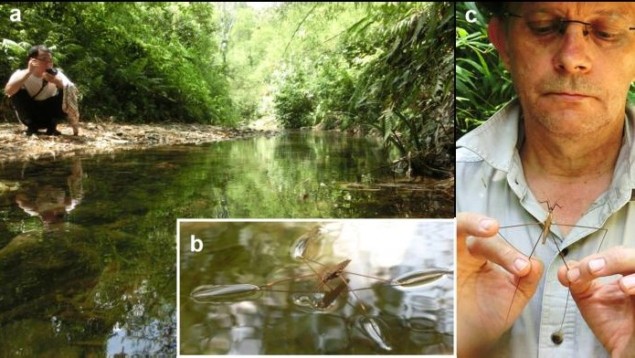
I grew up in the Canadian province of Ontario, so I spent a lot of time around lakes and streams when I was young. I remember being intrigued by water striders, which are long-legged insects that literally walk on water. Now that I live in England, we even have our own water striders living in our small garden pond.
Water striders’ legs are hydrophobic, so they float by repelling water, and under each leg is a dimple in the water – called a meniscus. One thing that I didn’t know about water striders is that they can jump very rapidly from the surface of the water when attacked from below by predators. Scientists have known for some time that the insect does this by pushing down on the water, making the dimple larger. Then, they use the upward recoil of the water’s surface to aid in their propulsion.
But now, an international team of researchers has discovered a new jumping mechanism that is used by larger water striders that weigh more than about 80 mg. When these behemoths push down on the water, their legs breakthrough the surface – so they cannot take advantage of the springy dimples.
Hairy legs
The researchers found that a layer of air becomes to attached to the hairy legs as they plunge into the water. This air increases the resistance that the legs encounter as they move down through the water, giving the insects the extra purchase needed to jump out of the water.
The observations were made during an expedition to Vietnam to study that country’s giant water strider and the layer-of-air hypothesis was quantified by creating a mathematical model. The team says that their research could help in the developing of robots that walk on water and could also shed light on the evolutionary development of water striders.
The research is described in Proceedings of the National Academy of Sciences.
Dancing peanuts
Speaking of air–liquid interfaces, physicists have studied the physics of “beer-dancing peanuts”, which I am told are all the rage in Argentina. To see the effect for yourself, drop a peanut into a glass of beer. Being denser than the liquid, the peanut will first sink to the bottom of the glass. However, after a few moments the peanut will float to the surface of the beer, where it will remain for a few moments before it sinks and repeats the process again.
Now, you are probably thinking that this has something to do with bubbles from the beer accumulating on the surface of the peanut until it is buoyant and floats to the surface. There, the bubbles probably burst, causing the nut to sink back down. And that’s what researchers in Germany have observed when they dropped peanuts into a litre of lager-style beer – with the added detail that the rotation of peanuts on the surface causes the bubbles to burst. What is more, they found that the process repeated itself for 150 min until the peanut came to rest at the bottom of the vessel. Something that only very slow tipplers would notice.
If you want to read more about this study, check out this article in Physics, which also explains how the study could shed light on the behaviour of magma under the Earth’s surface
- SEO Powered Content & PR Distribution. Get Amplified Today.
- PlatoData.Network Vertical Generative Ai. Empower Yourself. Access Here.
- PlatoAiStream. Web3 Intelligence. Knowledge Amplified. Access Here.
- PlatoESG. Automotive / EVs, Carbon, CleanTech, Energy, Environment, Solar, Waste Management. Access Here.
- BlockOffsets. Modernizing Environmental Offset Ownership. Access Here.
- Source: https://physicsworld.com/a/giant-water-striders-jump-differently-the-physics-of-beer-dancing-peanuts/



